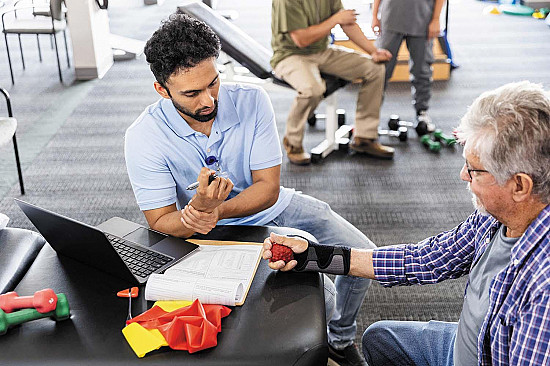
5 timeless habits for better health

What are the symptoms of prostate cancer?

Is your breakfast cereal healthy?

When pain signals an emergency: Symptoms you should never ignore

Does exercise give you energy?

Acupuncture for pain relief: How it works and what to expect

How to avoid jet lag: Tips for staying alert when you travel

Biofeedback therapy: How it works and how it can help relieve pain

Best vitamins and minerals for energy

Should you take probiotics with antibiotics?
Gout
Gout is a painful condition caused by too much uric acid in the blood and tissues. When the level of uric acid is too high, this substance can form tiny crystals that lodge in joints, causing joint pain. Uric acid crystals can also lodge in the kidneys, causing kidney stones. A related condition called pseudogout occurs when crystals of calcium accumulate in joints.
Gout occurs for three main reasons:
- eating foods rich in purines, which the body breaks down into uric acid. Foods rich in purines include anchovies, nuts, and organ foods such as liver, kidney, and sweetbreads.
- overproduction of uric acid by the body. This can happen with some genetic disorders or during chemotherapy for cancer. Sometimes there is no known reason for it.
- underexcretion of uric acid by the kidneys. Kidney disease can interfere with uric acid excretion, as can starvation, drinking too much alcohol, and the use of diuretics ("water pills") such as hydrochlorothiazide or furosemide.
Gout runs in some families. Among younger individuals, it affects men far more often than women. This gap shrinks among older men and women.
Symptoms of gout
The first attack of gout usually involves only one joint. The most common site is the big toe, though it can also be a knee, ankle, wrist, foot, or finger. The affected joint can become:
- red
- swollen
- painful
Later episodes of gout are more likely to hit several joints.
Gout attacks usually last for several days, but the pain is most intense during the first 24 to 36 hours. More than half of people who have had one attack of gout will have a second, usually within six months to two years.
The interval between attacks varies. Some people have them every few weeks, while others go years between attacks.
Some people with gout develop tophi — large, visible nodules made of uric acid crystals. Tophi can be large and disfiguring and may erode nearby bone tissue.
Diagnosing gout
Your description of your symptoms and medical and family history are an important part of diagnosing gout. Your doctor should ask you about your medications, diet, and alcohol use. He or she will check your joints, and may examine your skin for deposits of uric acid crystals.
A sample of fluid may be removed from a painful joint. This is examined under a microscope for uric acid crystals.
Blood tests may be done to measure the amount of uric acid in the blood and to check kidney function
Urine tests may be done to check kidney function.
Treating gout
If you've had an attack of gout, there are several things you can do to prevent its return:
- follow a healthy diet that is low in purines (try not to eat anchovies, brains, kidney, liver, sardines, sweetbreads, baker's or brewer's yeast)
- stay hydrated
- drink alcohol in moderation (no more than one drink a day) if at all
- lose weight if you are overweight or obese
- don't use diuretics (water pills) unless there are no other options available
To treat an ongoing attack of gout, taking a nonsteroidal anti-inflammatory drug such as ibuprofen (Advil, Motrin, and others), naproxen (Aleve, Naprosyn and others), or indomethacin (Indocin) can ease pain and inflammation.
It's best not to take aspirin for pain and inflammation because aspirin can raise the uric acid level in the bloodstream. Note that taking a low-dose aspirin for prevention of heart disease or stroke has little effect on gout.
An alternative to a non-steroidal anti-inflammatory drug is a corticosteroid. These can be taken by mouth or injected directly into the affected joint.
A drug called colchicine is sometime used to treat gout, but it often causes unpleasant side effects before it eases pain and swelling.
Medicines to lower uric acid in the bloodstream may be needed if you often have gout attacks, they don't promptly respond to treatment, they affect more than one joint at a time, or you have kidney disease. Uric-acid-lowering medications include:
- allopurinol (Aloprim, Zyloprim)
- febuxostat (Uloric)
- probenecid (Benemid, Probalan)
- pegloticase (Krystexxa)
Disclaimer:
As a service to our readers, Harvard Health Publishing provides access to our library of archived content. Please note the date of last review or update on all articles.
No content on this site, regardless of date, should ever be used as a substitute for direct medical advice from your doctor or other qualified clinician.

5 timeless habits for better health

What are the symptoms of prostate cancer?

Is your breakfast cereal healthy?

When pain signals an emergency: Symptoms you should never ignore

Does exercise give you energy?

Acupuncture for pain relief: How it works and what to expect

How to avoid jet lag: Tips for staying alert when you travel

Biofeedback therapy: How it works and how it can help relieve pain

Best vitamins and minerals for energy

Should you take probiotics with antibiotics?
Free Healthbeat Signup
Get the latest in health news delivered to your inbox!
Sign Up




